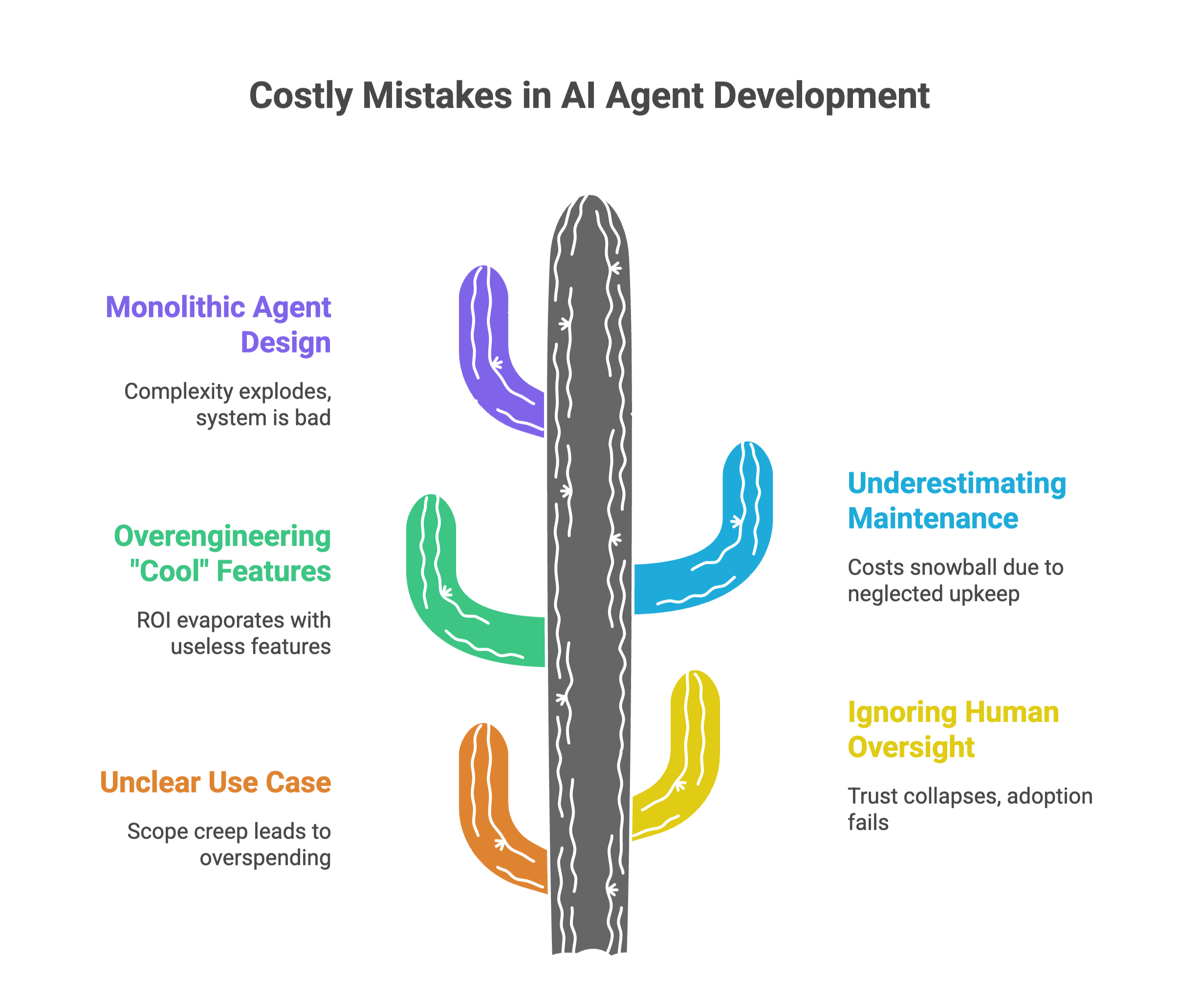Every executive I speak with starts AI conversations by asking:
“How much will it cost to build an AI Agent?”
That’s the wrong first question. The real question is:
“How do we make sure we don’t spend more than we should?”
The truth is, most organizations don’t blow their AI budgets because of the technology.
They blow it because of avoidable mistakes in how they scope, design, and roll out agents.
Here are the five biggest mistakes I see companies make — and how to avoid them.

1. Building Without a Clear Use Case → Scope Creep
One of the fastest ways to waste AI money is to start with a technology-first approach:
“We need an AI Agent — let’s build one.”
Without a crystal-clear business use case (e.g., reduce support tickets by 30%, cut research time in half, automate compliance checks), teams fall into scope creep. The agent starts simple but quickly grows into a Frankenstein project:
- “Can we also make it summarize reports?”
- “What if it could schedule meetings?”
- “Why not add sentiment analysis while we’re at it?”
Suddenly, the $50K pilot becomes a $250K multi-year experiment.
How to Avoid It:
- Anchor every agent to a measurable business outcome.
- Define success metrics upfront (e.g., cost savings, time reduction, revenue lift).
- Kill features that don’t serve the core outcome.
💡 My advice: Don’t chase “what’s possible.” Chase what moves the needle.
2. Ignoring Human-in-the-Loop → Trust Collapses
Another expensive mistake: assuming AI Agents can run fully autonomous from day one.
Reality check: AI Agents make mistakes. They hallucinate. They misinterpret. And when that happens without human oversight, trust collapses. Suddenly, your employees or customers stop using the system. Adoption tanks. Your investment sits idle.
Example:
- A law firm rolled out an AI research agent with no review loop. First week, it cited a non-existent case. Partners banned its use. $150K project → dead.
How to Avoid It:
- Always design with human-in-the-loop (HITL). Let the AI draft, humans approve. Let the AI recommend, humans decide.
- Automate confidence thresholds: if the model is 95% sure, auto-approve; if 60%, send to a human.
- Market the agent internally as augmentation, not replacement.
💡 ROI secret: HITL doesn’t slow you down — it ensures trust, which ensures adoption, which ensures ROI.
3. Overengineering for the “Cool Factor” Instead of ROI
I see this constantly: teams chase “wow factor” features that executives can demo in a boardroom, instead of focusing on the features that actually save money or make money.
- A chatbot that “talks like a human” with jokes and emojis is neat — but if it can’t resolve issues, it’s useless.
- A sales agent that runs a multi-agent conversation simulation is impressive — but if it doesn’t shorten the sales cycle, it’s wasted engineering.
The Cost Trap:
Cool features often mean more model calls, more integrations, more GPU costs. They drive up both build and maintenance budgets.
How to Avoid It:
- Prioritize ROI-first features: deflection, time savings, accuracy.
- Save “nice-to-haves” for later phases once the agent has already proven value.
- Ask every feature: “Does this help us make or save money?”
💡 Mantra: Business outcomes > cool factor.
4. Underestimating Ongoing Maintenance Costs
AI Agents aren’t “set it and forget it.” Models drift. Integrations break. APIs change. Regulations evolve.
A huge mistake I see is leaders only budgeting for the initial build and not the ongoing care and feeding. The result? Systems decay, employees lose trust, and organizations either pay massive “catch-up” costs later or abandon the agent altogether.
Real Costs That Sneak In:
- Model updates: New LLMs outperform old ones every 6–12 months.
- Compliance updates: Especially in finance/healthcare, rules shift constantly.
- User feedback loops: Tuning and retraining is ongoing, not one-time.
- Infrastructure scaling: As adoption grows, so do compute costs.
How to Avoid It:
- Budget 20–30% of initial build costs annually for maintenance.
- Assign an owner — either an internal AI Ops team or a managed service provider.
- Build feedback loops into your design from day one.
💡 My perspective: An agent without maintenance is like buying a car but never changing the oil. It’ll run… until it doesn’t.
5. Thinking One Agent Can Do Everything (vs. Modular Strategy)
A final mistake: companies try to build the “one AI to rule them all.”
They want a single agent that handles:
- Customer support
- Sales enablement
- Compliance checks
- Knowledge retrieval
- HR automation
The result? A bloated, unfocused system that’s bad at everything. Complexity balloons. Costs follow.
The Smarter Play:
Think modular strategy — a network of specialized agents that each do one thing well:
- Support Agent (ticket deflection)
- Sales Agent (lead follow-up)
- Knowledge Agent (internal RAG search)
- Compliance Agent (policy checks)
Each module has a clear ROI path. Each is easier to maintain. Together, they form a scalable ecosystem.
💡 Analogy: Don’t build a Swiss Army knife with 50 dull blades. Build a sharp set of scalpels.
The cost of AI Agents doesn’t just come from tech choices. It comes from strategic missteps.
- Build without a use case → scope creep.
- Ignore humans → adoption fails.
- Chase cool features → ROI evaporates.
- Forget maintenance → costs snowball.
- Go monolithic instead of modular → complexity explodes.
Avoid these five mistakes, and you not only save money — you unlock compounding ROI.
💡 The companies I’ve seen succeed with AI Agents aren’t the ones with the biggest budgets. They’re the ones that stay disciplined, modular, and ROI-driven.



.png)

.png)
.png)


.png)
.png)






















Christian Financial Credit Union
Huntington National Bank
Paqqets
Meridian Medical Management
Thales Group
Meridian Medical Management